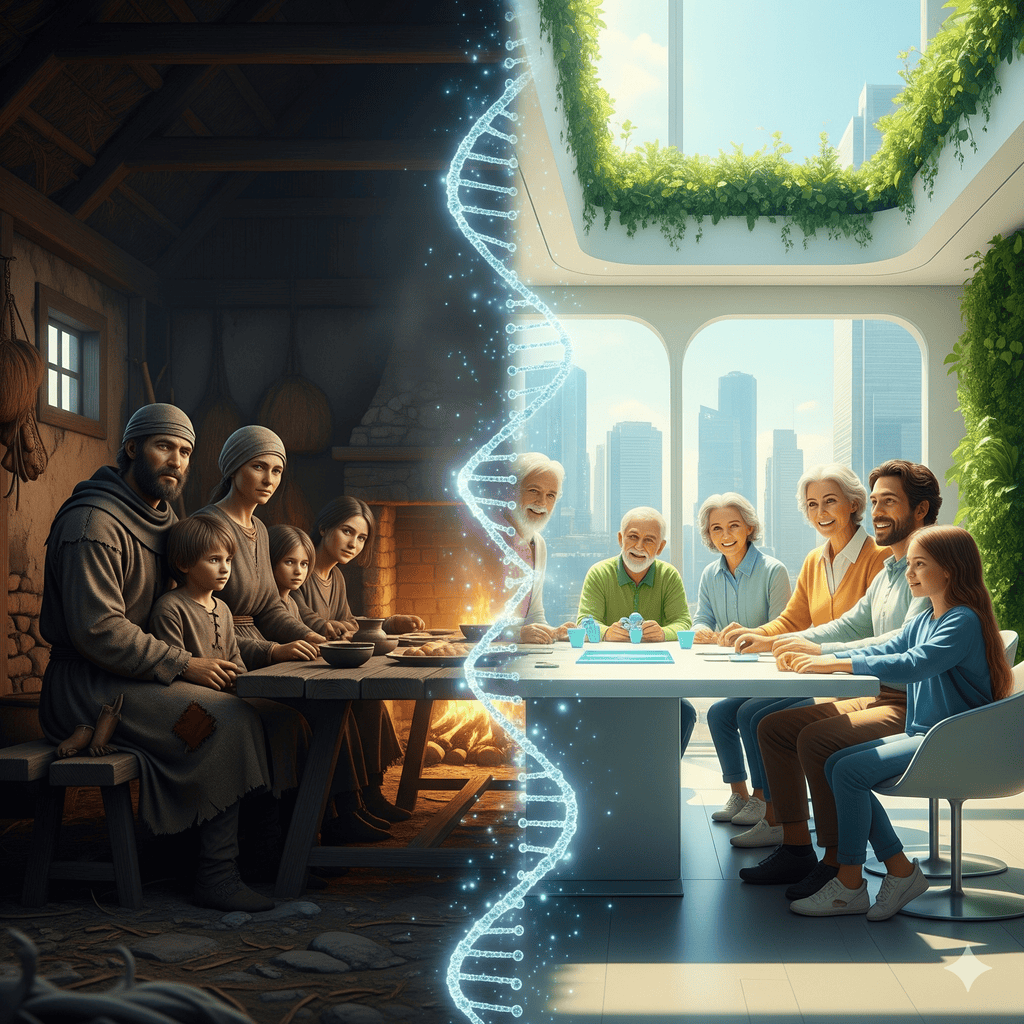From 35 to 120? How We Hacked a Millennium of Life and What Your Future Holds.
Imagine a world where reaching your 40th birthday is cause for a grand celebration, marking you as a family elder. A world where a toothache could be a death sentence, and the birth of a child is as much a miracle as it is a potential tragedy. This isn’t a post-apocalyptic movie script. This was the reality for your ancestors 1000, or even just 300, years ago.
At livelongernow.org, we don’t just look to the future; we analyze the past to understand the spectacular leap we’ve made. This history is the ultimate proof that the limits of human lifespan are far more flexible than we might think.
The Dark Ages: Survival as a Luxury (c. 1000-1400 AD)
- Average Life Expectancy: 30-35 years (heavily skewed by immense infant mortality). If you made it to 20, you had a decent chance of seeing 50.
- Major Life-Shortening Factors:
- Famine and Malnutrition: The climate was unstable (Little Ice Age), and harvests were unreliable. A lack of essential nutrients weakened the immune system.
- Infectious Diseases: The absence of sanitation, contaminated water, and close living quarters with animals created a perfect storm for pandemics. The Black Death in the 14th century wiped out 30% to 50% of Europe’s population.
- War and Violence: Conflict was constant, and battlefield medicine was non-existent. A simple wound could easily lead to a fatal infection.
- Lack of Medical Knowledge: Illnesses were blamed on evil spirits, “bad air” (miasma), or divine wrath. Treatments involved bloodletting and herbs of questionable efficacy.
Quality of life? It was focused entirely on survival. The concept of a “healthy lifestyle” didn’t exist. All that mattered was the here and now.
The Renaissance & Enlightenment: A Glimmer of Hope (c. 1400-1800 AD)
- Average Life Expectancy: A slow increase to around 35-40 years.
- Key Life-Extending Factors:
- Growth of Cities and Trade: Better food distribution, though still far from perfect.
- The Dawn of Science: The invention of the printing press allowed for the faster spread of medical knowledge, however primitive. A basic understanding of human anatomy began to form.
- New Threats:
- “Colonial” Diseases: Geographic discoveries led to an exchange not only of goods but also of pathogens (e.g., syphilis in Europe).
- Urban Density: While cities were engines of progress, their sanitary conditions were appalling, fostering epidemics of cholera and typhus.
The Industrial Revolution: Two Sides of Progress (19th Century)
- Average Life Expectancy: A jump to about 40-45 years (in developed countries).
- Key Life-Extending Factors:
- Agricultural Revolution: New technologies and fertilizers significantly increased food production, reducing famine.
- The Birth of Hygiene: The discoveries of Louis Pasteur and Robert Koch (germ theory) revolutionized medicine. People started washing hands, sterilizing instruments, and building sewer systems.
- First Vaccines: The smallpox vaccine saved millions of lives.
- New Threats:
- Industrial Pollution: Smog, contaminated water, and harsh factory conditions took a deadly toll.
- Urban Stress and Accidents: Factory work was dangerous, and life in overcrowded cities generated new health problems.
The 20th Century: The Longevity Explosion
- Average Life Expectancy: A dramatic leap from ~47 years in 1900 to nearly 80 years in 2000 in developed nations. This is nearly a doubling of lifespan in just three generations!
- Key Life-Extending Factors:
- Antibiotics: Alexander Fleming’s discovery of penicillin was a miracle. Pneumonia and tuberculosis ceased to be death sentences.
- Mass Vaccinations and Public Health: Diseases like polio, measles, and whooping cough were eliminated or drastically reduced.
- Understanding of Diet and Lifestyle: The impact of vitamins, nutrients, exercise, and sleep on health began to be scientifically studied.
- Medical Advances: Progress in surgery, cardiology, oncology, and transplantation.
- New Threats:
- Chronic Lifestyle Diseases: Infectious diseases were replaced by heart disease, cancer, type 2 diabetes, and obesity. These “diseases of affluence” result from diets high in processed foods and sedentary lifestyles.
“For 99% of human history, we fought for calories. Today, for the first time, our main enemy has become their excess.” – paraphrased from Prof. Daniel Lieberman, Harvard University.
What Awaits Us in the Next 100 Years? A Data-Driven Prediction.
Analyzing this incredible progress, we see that science and technology have been the engines of change. The next 100 years will bring a revolution that may make the 20th century look like a mere warm-up.
- Average Life Expectancy by 2125: Conservative estimates suggest 95-100 years globally. Optimistic forecasts, factoring in medical breakthroughs, point to 110-120 years becoming the norm for those born today.
- Key Future Technologies:
- Personalized Medicine and AI: Therapies tailored to your unique DNA. AI will analyze your health data in real-time, predicting diseases before symptoms appear.
- Gene Therapies (CRISPR): “Fixing” the genes responsible for cancer, Alzheimer’s, or Parkinson’s disease.
- Regenerative Medicine: Growing new organs from stem cells, reversing cellular aging processes (senolytics).
- New Threats:
- Inequality of Access: Will only the wealthiest be able to afford a health “upgrade”?
- Climate Change: New pandemics, challenges with access to clean water and food.
- Mental Health: In a world saturated with technology and information, depression and anxiety could become the number one “lifestyle disease.”
The story of human life is a tale of overcoming barriers that once seemed insurmountable. From fighting to survive until tomorrow, we have reached a point where we are planning our quality of life 50 years from now.
Today, science is knocking on your door, offering tools your great-grandparents couldn’t even dream of. It’s no longer just about lifespan (how many years you’ll live), but about healthspan (how many of those years you’ll live in full health).
Do you want to know your personal longevity potential, based on the latest research and artificial intelligence analysis? Stop guessing. Start knowing. Complete our assessment and receive a personalized report that shows you where you are and how you can “hack” your own future.
Discover Your Longevity Potential – Take the Assessment Now!
Interesting Scientific Publications:







